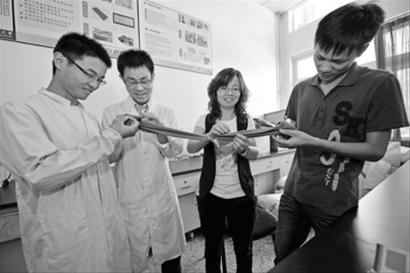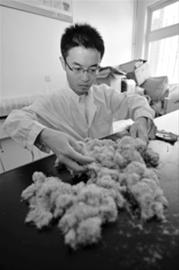

Dalian University of Technology Institute of Green Fiber Materials Applied Technology. Socks made from discarded coffee grounds.

Researchers are developing recycled fibers.
(Reporter/Xu Xiaojing) At the 15th Shanghai International Textile Industry Exhibition in mid-June, a piece of news attracted people's attention: “Supporting recycling of waste textiles†was first written into the “12. In the "Five Plan" (2011-2015), the new concept of "recycled apparel" officially entered our vision.
What exactly is "recycled clothing"? What has been done in this area in our province? If "recycled clothing" really wants to enter the lives of ordinary people, what problems need to be solved? With fresh and curious, the reporter conducted interviews with related departments, research institutions, and garment processing companies.
More than 10 years ago, there were research institutions in our province that peanut shells and corn husks could be made into recycled fibers. Xinhua News Agency reported that according to the “Twelfth Five-Year Plan†of China's textile industry, “supporting the recycling of used textiles†already has an expected “ Schedule: In the next five years, a textile recycling fiber recycling system will be established. By 2015, the total fiber processing volume in China will reach 51.5 million tons, of which 15% will be recycled fiber.
“Actually, in the recycling of waste fibers, our province’s research work is still relatively advanced. As early as 10 years ago, research institutions began to appear.†When reporters interviewed the provincial textile industry association about the new issue of “recycled clothingâ€, Relevant persons said to reporters.
Originally, in 1996, Dalian Institute of Light Industry (changed to Dalian University of Technology in 2007) established the Key Laboratory of Green Fiber Materials Applied Technology Research Institute, which is also the province's first fiber waste recycling research institute. There are other similar research institutes after it.
On July 4, the reporter visited the Research Institute of Green Fiber Materials Applied Technology of Dalian University of Technology. In the laboratory, several master graduate students are conducting experiments under the guidance of Professor Yu Yongling. What is new is that they used to waste all the waste they used: peanut shells, waste hemp, loofah, corn bran, and so on.
Professor Yu Yongling said that after scientific treatment, these wastes can be made into recycled fibers and reused in production and life.
Yu Yongling is an advocate and founder of this laboratory. She said: “Today, the pollution of the global environment is becoming more serious and all kinds of resources are getting tighter. Recycling fiber is of great significance. Not only can we save a lot of resources, but it can also play an active role in improving the ecological environment.â€
From a global perspective, the consumption of fiber is very alarming. Looking at the total amount of fiber waste in mainland China in 2009, the figures are very large: 3.6 million tons of waste was generated during the processing of fiber, and 2.34 million tons of fiber waste was generated during the consumption process, for a total of 594 Ten thousand tons.
Yu Yongling said: "If such a large amount of fiber waste is used effectively, it will become a valuable resource."
Since its founding more than 10 years ago, the Institute of Green Fiber Materials Applied Technology has been devoted to the evaluation of waste fiber materials and the establishment of utilization standards, research on the detection, classification and separation technologies of waste fiber materials, and the research and development of series recycled products to increase fiber waste. The reduction, harmlessness, resource treatment level.
“We hope that there will be more fiber waste recycling products around us in the future,†Yu Yongling said.
Europe and the United States have used recycled textiles for decades. In our province, only garment enterprises of scale have produced 650 million pieces of clothing each year. There is a lot of space for recycling. So, what is the relationship between recycled fiber recycling and “recycled clothing� According to reports, the basic components of textiles such as clothing are fibers. Fiber is a tough and resilient material. Textile fibers are classified into natural fibers, animal fibers, and chemical fibers. These three types of fibers can be further subdivided into several types. For example, natural fibers include cotton and hemp, and animal fibers include wool and silk, and chemical fibers include Nylon, polyester and so on.
If only from a literal point of view, "recycled clothing" should refer to the process of restoring the fibers in clothes by recycling used clothes, recreating the textiles, and finally remaking the clothes.
However, according to Yu Yongling, the concept of “recycled clothing†is actually very extensive. The recycling of used clothing is just one form. Because recycled fibers do not necessarily have to be extracted from waste clothing, recycled fibers can be extracted from other waste materials produced in other industries. The production of these recycled fibers into garments is called “recycled clothingâ€. Fibers can now be extracted from waste plastics (such as mineral water bottles) and used as raw materials for clothing production.
In general, the process of making recycled garments from recycled waste can be called "recycled garments."
In 1998, Professor Yu Yongling worked as a senior visiting scholar at a fiber recycling technology center in Japan for half a year to learn about the production of “recycled apparel†in Japan. She said: "In Japan, whether it is the government, research institutions, or some non-governmental organizations, they are actively advocating and advancing this work."
She had collected relevant data. At that time, the total fiber consumption in Japan was about 2.287 million tons per year, and the total amount of waste fibers was about 1.712 million tons. The total recovery was about 184,000 tons, of which the recycled and recycled fibers were approximately 16.2 million tons, that is, the re-commodification rate of fiber products is about 9.5% of the total waste.
Recycled textiles have also been used in Europe and the United States for several decades.
Of course, "recycled clothing" is only the beginning in China. In our province, although there was a research institute more than 10 years ago, it is still only at the research level. There is almost no behavior of companies that actually recycle and recycle.
"With the improvement of people's living standards, clothing will be updated faster and faster. If you do not recycle, waste will inevitably show a growth trend." Professor Yu Yongling said.
At present, textile waste can be divided into consumer goods, industrial goods, and industrial consumer goods. Industrial textile waste includes yarns, edging and other leftovers produced in various processes such as textile mills and garment factories. Living textile waste includes clothing, shoes and hats, socks, and gloves. Sources include households, hotels, and public facilities. Places, etc., are numerous and complex.
The reporter learned from the Provincial Textile Industry Association that at present, only garment enterprises of scale in our province produce 650 million pieces of clothing each year. If we can practice and make breakthroughs in the "recycled apparel" aspect, it will undoubtedly be a good thing for the country and the people.
Waste clothing recycling will have to pass a few customs?
The concept of cost, technology, environmental protection and consumption have yet to be resolved and the reporter’s investigation has revealed that the reason why the recycling of used clothes is still at the conceptual stage, mainly because the technology has not yet reached a level of maturity and the production cost is relatively high. Textile companies are difficult Profitability can be said to be effortless, so for the time being, no company has yet to practice it.
The waste fiber product has a high degree of mixing, and it is demanded that the fiber product to be recycled be separated and decomposed by fiber components.
Experts suggest that to develop the recycling of used textiles, first of all, it is necessary to cultivate people's awareness of environmental protection and guide the classification and management of garbage. There is also a technical breakthrough to promote the production and technological innovation in this area to reduce costs; the government policy We must give necessary industrial support to the regenerated textile production enterprises so that "recycled clothing" can truly enter our lives.
How to let consumers feel comfortable accepting “recycled clothing†is also an important part, which depends on publicity to raise awareness. Of course, policy regulations, legal protection, standard setting, and market guidance are all necessary conditions. It must be ensured that "recycled garments" are safety garments.
The reporter learned that Yu Yongling has just completed the "feasibility determination of recycling methods for textile waste". She summed up: "This topic is to study how fiber recycling uses the lowest cost, what kind of utilization is the most reasonable, and what kind of recycled products are the most competitive. In fact, these problems are whether fiber recycling can successfully enter the people. The key to life."
Link “Recycled Apparel†is very popular in Japan Japan is one of the countries with better fiber recycling in the world. In recent years, there have been more and more Japanese companies producing clothes such as suits and coats that can be recycled and reused many times. Recently, well-known clothing brand manufacturers have launched a female job search uniform made of recycled polyester fiber.
Teijin Corporation of Japan has developed the world's first complete recovery technology for polyester fiber. Compared with the polyester material made of petroleum, the energy consumption index and the carbon dioxide emission during production can be reduced by about 80%.
In Japan's "recycled apparel" products, the logo of ECOLOG is printed, which means environmental protection products. Such clothes are highly favored by environmental protection volunteers.
U.S. Supports “Recycled Apparel†at Higher Prices The U.S. Congress and the European Parliament have issued an ordinance that stipulates that as long as textiles are accompanied by a “recycled†logo, the price can be increased by about 10% compared to ordinary textile products. After more than 20 years of publicity and promotion, consumers nowadays are increasingly recognizing recycled textiles. Many people are willing to pay for clothing after seeing a “recycled†label.
Rain Jacket,Non-Disposable,Sealant Hooded Rain Jacket,Raincoat For Children
Rrain Jacket Coat,Baby Bibs,Baby Clothes Set Baby Rom Co., Ltd. , http://www.hzraincoat.com